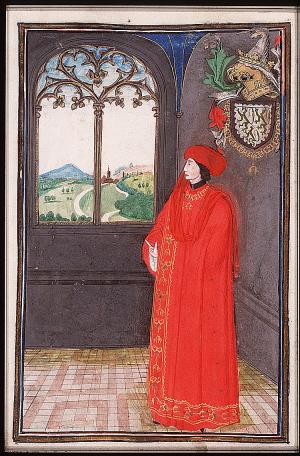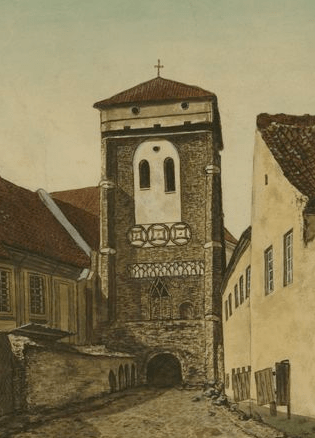Two Journeys by a Burgundian Knight Through the GDL
Guillebert de Lannoy (1386–1462) was a Burgundian knight, French diplomat and traveller. He travelled through Europe while carrying out his diplomatic missions. On order by King of England Henry V, he visited many countries, and agreed on a common policy that was directed against the Turks, and the liberation of Jerusalem. Guillebert de Lannoy discussed these issues with GDL ruler Vytautas in 1421. This diplomat to the GDL, who visited the country twice, provided information about the land, its cities and people.
Impressions of Lithuania: cities and empty expanses
In 1413, de Lannoy travelled to visit the Teutonic Order to participate in military crusades against the pagans, but after the Battle of Grunwald, the Order did not organize any further military crusades. This is why at the end of 1413, this diplomat travelled from Königsberg to Livonia. He passed through Memmel. In his memoirs he notes that there was a castle not far from the border with the Samogitians. The Lithuanian shoreline appeared empty and sandy to him. After reaching Libau (Liepaja), he continued further through Livonian cities to Riga. He visited Novgorod and Pskov. In the latter he was not received in a hospitable manner, and later he was forced to escape. Returning to Livonia in 1414 through the fortress of Daugavpils, he travelled to the GDL. Guillebert de Lannoy wrote in his memoirs that he drove for two days and nights with a sledge through the huge forest and through lakes, not meeting a soul until he reached one of the manor estates of GDL ruler Vytautas, which was 12 miles from Vilnius. On this leg he saw many farmhouses, lakes and forests.
During the journey, this diplomat found the GDL to be an empty land full of lakes and huge forests.
He mentions that he saw Vytautas’ castle in Vilnius, which was reinforced by stone and mortar, but many of its structures were of wood. The ruler was not in the castle, and he met with two sisters of Vytautas’ wife. The city of Vilnius appeared to be long and narrow and did not have a defensive wall; there were wooden buildings and a few stone churches. However, he emphasized that in other cities he also saw stone churches, and some were being built in earnest. De Lannoy mentions that Lithuanians grew long, loose hair, while the women adorned themselves with garments that were similar to those of women in eastern France. He went to Trakai, which to him seemed to be like a big city; there were two castles – a new castle that was similar to those he saw in France, built with bricks on an island. He also was surprised there was no defensive wall around the city, while the houses were just wooden and not situated in an orderly manner. He said that Lithuanians, Russians, Germans, and many Tatars and Jews lived in Trakai (the Karaites were called Jews by de Lannoy). What caught his eye was the menagerie in Trakai, which had bison, horses, mules, wild horses, bears, wild boars, elk, deer and other animals. After leaving Trakai he reached Punia. It was there that there was a large wooden fortified castle, where Vytautas would spend almost the entire winter. At the time the ruler, his wife, and his daughter Sophia (she was married to the ruler of Moscow) and niece were at the castle. De Lannoy did not write about his meeting with Vytautas, but in his writing he emphasized the ruler’s generosity to visitors from other countries. Guests were released from taxes, and during their stay they were not at a lack of anything. It was from there that de Lannoy went to Kaunas, which he describes as a large and well-fortified city with a large castle. He continued his journey by sledge along the frozen riverbed of the Nemunas and saw two castles. Closer to Prussia, at the GDL border, was the start of the forested and uninhabited area, which rivers cut through.
A meeting with Vytautas the Great and gifts almost lost
The second time Guillebert de Lannoy visited the GDL was in July 1421. First of all he met Vytautas and his wife Uliana at Kremenets Castle in Volhynia. The ruler was surrounded by many dukes, duchesses and knights, among whom was one Tatar.
De Lannoy gave Vytautas gifts from the king of England.
Vytautas took in the diplomat in a hospitable manner and organised three feasts and put de Lannoy at his table. During the nine days of his visit, de Lannoy saw how envoys from Novgorod and Pskov came to Vytautas, and that they brought, as he writes, sixty different kinds of gifts: various luxurious furs, silk, gold and silver. However, Vytautas refused those who had come from Pskov.
Vytautas gave silk garments, luxurious furs and hats, decorated shields, a Tatar bow, and four horses to de Lannoy, while the grand duchess gave a golden necklace and a large Tatar florin that was for being worn around the neck. Vytautas also showered gifts upon de Lannoy’s seven companions. According to de Lannoy, he refused to take one hundred gold ducats and 25 silver bars that Vytautas wanted to give him, because the ruler supported the Czech Hussites that were fighting against the rulers of Catholic European countries. Vytautas provided a few safe-conduct documents that were written in Tatar, Russian and Latin that would allow them safe passage, and warned that it would not be possible to travel on the Danube because there was an intense internal conflict in Turkey after the death of the sultan.
During the journey, de Lannoy was accompanied by eighteen companions provided by Vytautas.
De Lannoy continued to Wallachia and stayed at the fortified harbour of Belgorod in Moldova, where he was ambushed, beaten, robbed and tied to a tree on the shore of the River Dnieper. The Moldavian voivodes managed to find the thieves and return some of the gifts given by Vytautas back to de Lannoy. De Lannoy continued his journey to the Crimean khan, who was said to be a good friend of Vytautas.
Literature: P. Klimas, Ghillebert de Lannoy. Dvi jo kelionės Lietuvon Vytauto Didžiojo laikais (1413–14 ir 1421 metais) (Atmušta iš II Praeities tomo). Kaunas, 1931.
Tomas Čelkis




